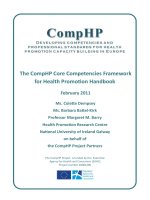HEALTHY PEOPLE - The Surgeon General’ s Report On Health Promotion And Disease Prevention doc
Bạn đang xem bản rút gọn của tài liệu. Xem và tải ngay bản đầy đủ của tài liệu tại đây (12.51 MB, 262 trang )
HEALTHY PEOPLE
The Surgeon General’s Report On
Health Promotion And Disease Prevention
HEALTHY PEOPLE
The Surgeon General’s Report On
Health Promotion And Disease Prevention
1979
U.S. DEPARTMENT OF HEALTH, EDUCATION, AND WELFARE
Public Health Service
Office of the Assistant Secretary for Health and Surgeon General
DHEW (PHS) Publication No. 79-55071
For sale by the Superintendent of Documents. U.S. Government Printing Office
Washington, D.C. 20.102
Stock Xumber 017-001-00416-2
DEPARTMENT OF HEALTH. EDUCATION. AND WELFARE
W*SHINCTON. D c. -1
SURGEON GENERAL
OF THE
PUBLIC HEALTH SERVICE
The Honorable Joseph A. Califano, Jr.
Secretary of Health, Education, and Welfare
Dear Mr. Secretary:
I am pleased to transmit herewith the manuscript of the
Surgeon General's Report on Health Promotion and Disease
Prevention.
I believe this will be an important document for the
American people.
Many people and institutions, too numerous to acknowledge,
have provided valuable assistance in preparing this report.
I
would particularly like to express appreciation to
Dr. J. Michael McGinnis, Acting Deputy Assistant Secretary
for Health (Disease Prevention and Health Promotion) and
his staff, and to Dr. David Hamburg, President of the
Institute of Medicine,
of the National Academy of Sciences,
for his leadership in mobilizing the resources of the
Institute to provide the accompanying papers which present
documentation for the report.
Sincerely yours,
ssistant Secreta
for Health and
Surgeon General
July 1979
TABLE OF CONTENTS
SECRETARY'S FOREWORD
SECTION
I
- TOWARD A HEALTHIER
AMERICA . . . . . I- 1
CHAPTER 1: INTRODUCTION AND SUMMARY. . . .
l- 1
CHAPTER 2:
RISKS
TO GOOD HEALTH. . . . . . 2-
1
Major Risk Categories . . . . . 2- 2
Risk Variability. . . . . . . . 2- 3
Age-Related Risks . . . . . . . 2- 5
Assessing Risk. . . . . . . . . 2- 6
The Role of the Individual. . . 2- 7
SECTION
II
- HEALTH GOALS. . . . . . . . . . .
.II-
1
CHAPTER 3:
CHAPTER 4:
CHAPTER 5:
CHAPTER 6:
HEALTHY INFANTS . . . . . . . .
Subgoal:
Reducing the Number
of Low Birth Weight Infants .
Subgoal: Reducing the Number
of Birth Defects. . . . . . .
HEALTHY
CHILDREN. . . . . . . .
Subgoal:
Enhancing Childhood
Growth and Development. . . .
Subgoal: Reducing Childhood
Accidents and Injuries. . . .
HEALTHY ADOLESCENTS AND
YOUNG ADULTS. . . . . . . . .
Subgoal: Reducing Fatal Motor
Vehicle Accidents . . . . . .
Subgoal: Reducing Alcohol and
Drug Misuse . . . . . . . . .
HEALTH ADULTS . . . . . . . . .
Subgoal:
Reducing Heart
Attacks and Strokes . . . . .
Subgoal:
Reducing Death
from Cancer . . . . . . . . .
3- 1
3- 5
3- 8
4-
1
4- 6
4-10
5- 1
5- 6
5- 7
6- 1
6- 6
6-12
CHAPTER 7:
HEALTHY OLDER ADULTS. . . . . . 7-
Subgoal:
Increasing the Number
of Older Adults Who Can
Function Independently. . . . 7-
Subgoal: Reducing Premature
Death from Influenza and
Pneumonia . . . . . . . . . .
7-12
SECTION
III
- ACTIONS FOR HEALTH
. . . . . . . .III-
CHAPTER 8:
CHAPTER 9:
CHAPTER
10:
PREVENTIVE HEALTH SERVICES.
8-
Family Planning
8-
Pregnancy and Infant Care
8-
6
Immunizations
8-16
Sexually Transmissible Diseases
Services.
8-20
High Blood Pressure Control . .
8-23
HEALTH PROTECTION
9-
Toxic Agent Control
9-
2
Occupational Safety and
Health.
9-11
Accidental Injury Control
9-17
Fluoridation of Comnunity
Water Supplies.
9-26
Infectious Agent Control.
9-28
HEALTH PROMOTION.
lo-
1
Smoking Cessation
lo-
5
Reducing Misuse of Alcohol
and Drugs
lo-11
Improved Nutrition.
lo-17
Exercise and Fitness.
lo-24
Stress Control.
lo-28
SECTION
IV
- CHALLENGE TO THE NATION . . . . . . IV-
1
CHAPTER
11:
CHALLENGE TO THE NATION . . . .
ll-
1
The Obstacles . . . . . . . . .
ll-
1
Opportunities for Action. . . .
ll-
3
APPENDIX I - MEASURES FOR BETTER HEALTH -
A SUMMARY. . . . . . . . . . . . . AI- 1
APPENDIX II
- SOURCES OF ADDITIONAL
INFORMATION. . . . . . . . . . . . AII- 1
ACKNOWLEDGEMENTS . . . . . . . . . . . . . . . AIII- 1
SECTION I - TOWARD A HEALTHIER AMERICA
CHAPTER I
INTRODUCTION AND SUMMARY
The health of the American people has never been
better.
In this century we have witnessed a remarkable
reduction in the life-threatening infectious and
communicable diseases.
Today,
seventy-five percent of all deaths in
this country are due to degenerative diseases such
as heart disease,
stroke and cancer (Figure 1-A).
Accidents rank as the most frequent cause of death
from age one until the early forties.
Environmental
hazards and behavioral factors also exact an unnec-
essarily high toll on the health of our people.
But
we have gained important insights into the preven-
tion of these problems as well.
It is the thesis of this report that further im-
provements in the health of the American people can
and will be achieved not alone through increased
medical care and greater health expenditures but
through a renewed national commitment to efforts
designed to prevent disease and to promote health.
This report is presented as a guide to insure even
greater health for the American people and an
improved quality of life for themselves, their
children and their children's children.
Americans Today are Healthier Than Ever
Since 1900, the death rate in the United States
has been reduced from 17 per 1,000 persons per year
to less than nine per 1,000 (Figure 1-B). If
mortality rates for certain diseases prevailed today
as they did at the turn of the century, almost
400,000 Americans would lose their lives this year
to tuberculosis,
almost 300,000 to gastroenteritis,
80,000 to diphtheria,
and 55,000 to poliomyelitis.
Instead, the toll of-all four diseases will be less
than 10,000 lives. - -
1-3
FIGURE 1-A
DEATHS FOR SELECTED CAUSES AS A PERCENT
OF ALL DEATH& UNITED STATES,
SELECTED YEARS, 190&1877
Influenza and weumonia
100
90
60
70
60
I-
f
0 60
f
40
I-
30
I-
2c
I-
ia
l-
0
m Major cardiovascular diseases
0 All other causes
1900
1920 1940
1960 1970
1977
NOTE: 1977 data are pro”,mnal. ata ‘or #I Other year5 are flrldl.
Source:
National Center for Health Statistics, Division of Vital Statistics
l-2
FIGURE 16 FIGURE 16
DEATH BATES BY AGE: UNeTED STATES, DEATH BATES BY AGE: UNeTED STATES,
SELECTED YEARS lsoOl977
SELECTED YEARS lsoOl977
170-
65 years and over 65 years and over
60 -
50 -
40 -
30 -
20 -
*-
1524 v-*
0.8 -
0.7 -
0.6 -
0.5 -
z.::
1900 1910
1920 1930
1940 1950
1960 1970
1960
SOURCE: National Center for Health Statistics, Division of Vital Statistics.
1-3
We
status
0
have seen other impressive gains in health
in the past few years.
In 1977, a record low of 14 infant deaths
per 1,000 live births was achieved.
Between 1960 and 1975, the difference in
infant mortality rates for nonwhites and
whites has cut in half.
Between 1950 and 1977, the mortality rate
for children aged one to 14 was halved.
A baby born in this country today can be
expected to live more than 73 years on
average, while a baby born in 1900 could be
expected to live only 47 years.
Deaths due to heart disease decreased in
the United States by 22 percent between
1968 and 1977.
During the past decade the expected life
span for Americans has increased by- 2.7
years. In the previous decade it increased
by only one year.
For this, much of the credit must go to earlier
efforts at prevention, based on new knowledge which
we have obtained through research.
Nearly all the
gains
against the once-great killers which also
included typhoid fever, smallpox, and plague have
come as the result of improvements in sanitation,
housing,
nutrition,
and immunization.
These are all
important to disease prevention.
Rut some of the recent gains are due to measures
people have taken to help themselves changes in
lifestyles resulting from a growing awareness of the
impact of certain habits on health.
Can We Do Better?
To be sure, as a Nation we have been expending
large amounts of money for health care.
l-4
0
From 1960 to 1978 our total spending as a
Nation for health care mushroomed from $27
billion to $192 billion.
0
In 1960 we spent less than six percent of
our GNP on health care. Today,
the total
is about nine percent. Almost 11 cents of
every federal dollar goes to
health
expenditures.
0
In the years from 1960 to 1978 annual
health expenditures increased over 700
percent.
Yet, our 700 percent increase in health spending
has not yielded the striking improvements over the
last 20 years that we might have hoped for. To a
great extent these increased expenditures have been
directed to treatment of disease and disability,
rather than prevention.
Though,
particularly in recent years, we have
made strides in prevention, much is yet to be
accomplished.
For example,
recent figures
indicate that we
still lag behind several other industrial nations in
the health status of our citizens:
0
12 others do better in preventing deaths
from cancer;
l
26 others have a lower death rate from
circulatory disease;
0 11 others do a better job of keeping babies
alive in the first year of life; and
0
14 others have a higher level of life
expectancy for men and six others have a
higher level for women.
Prevention
- An Idea Whose Time Has Come
Clearly, the American people are deeply inter-
ested in improving their health. The increased
l-5
attention now being paid to exercise, nutrition,
environmental health and occupational safety testify
to their interest and concern with health promotion
and disease prevention.
The linked concepts of disease prevention and
health promotion are certainly not novel.
Ancient
Chinese texts discussed ways of life to maintain
good health and in classical Greece, the followers
of the gods of medicine associated the healing arts
not only with the god Aesculapius but with his two
daughters, Panacea and Hygeia. While Panacea was
involved with medication of the sick, her sister
Hygeia was concerned with living wisely and pre-
serving health.
In the modern era,
there have been periodic
surges of interest leading to major advances in pre-
vention. The sanitary reforms of the latter half of
the 19th century and the introduction of effective
vaccines in the middle of the 20th century are two
examples.
But, during the 1950s and 196Os, concern with
the treatment of chronic diseases and lack of
knowledge about their causes resulted in a decline
in emphasis on prevention.
Now, however,
with the growing understanding of
causes and risk factors for chronic diseases, the
1980s present new opportunities for major gains.
Prevention is an i 'ea whose time has come. We
have the scientific knowledge to begin to formulate
recommendations for improved health. And, although
the degenerative diseases differ from their infec-
tious disease predecessors in having more and more
complex causes,
it is
now clear that many are
preventable.
Challenges for Prevention
We are now able to identify some of the major
risk factors responsible for most of the premature
morbidity and mortality in this country.
l-6
Cigarette Smoking
Cigarette smoking is the single most preventable
cause of death. It is clear that cigarette smoking
causes most cases of lung cancer and that fact is
underscored by a consistent decline in death rates
from lung cancer for former male cigarette smokers
who have abstained for 10 years or more.
Cigarette smoking is now also identified as a
major factor increasing risk for heart attacks.
Even in the absence of other important risk factors
for heart disease such as high blood pressure and
elevated serum cholesterol smoking nearly doubles
the risk of heart attack for men.
Though the actual
cause of the unprecedented
decline in heart disease in the last ten years is
not entirely understood,
it is noteworthy that the
prevalence of these three risk factors also declined
nationally during this same period.
Alcohol and Drugs
Misuse of alcohol and drugs exacts a substantial
toll of premature death, illness, and disability.
Alcohol is a factor in more than 10 percent of
all deaths in the United States.
The proportion of
heavy drinkers in the population grew substantially
in the 196Os, to reach the highest recorded level
since 1850.
Of particular concern is the growth in use of
both alcohol and drugs among the Nation's youth.
Problems resulting from these trends are sub-
stantial but preventable. Our ability to deal with
them depends, in many ways, more on our skills in
mobilizing individuals and groups working together
in the schools and communities, than on the efforts
of the health care system.
l-7
Occupational Risks
Also more widely recognized as threats to health
are certain occupational hazards.
In fact, it is
now estimated that up to 20 percent of total cancer
mortality may be associated with these hazards.
The
true dimensions of the asbestos hazard, for example,
have become manifest only after a latency period of
perhaps 30 years.
And rubber and plastic workers, as well as
workers
in some coke oven jobs,
are exhibiting
significantly higher cancer rates than the general
population.
Yet,
once these occupational hazards are de-
fined, they can be controlled. Safer materials may
be substituted; manufacturing processes may be
changed to prevent release of offending agents;
hazardous materials can be isolated in enclosures;
exhaust methods and other engineering techniques may
be used to control the source; special clothing and
other protective devices may be used; and efforts
can be made to educate and motivate workers and
managers to comply with safety procedures.
Injuries
Injuries represent still another area in which
the toll of human life is great.
Accidents account for roughly 50 percent of the
fatalities for individuals between the ages of 15 to
24.
But the highest death rate for accidents occurs
among the elderly, whose risk of fatal injury is
nearly double that of adolescents and young adults.
In 1977, highway accidents killed 49,000 people
and led to 1,800,OOO disabling injuries. In 1977,
firearms claimed 32,000 lives, and were second only
to motor vehicles as a cause of fatal injury.
Falls, burns, poisoning, adverse drug reactions
and recreational
accidents
all
accounted for a
significant share of accident-related deaths.
l-8
Again, the potential to reduce these tragic and
avoidable deaths lies less with improved medical
care than with better Federal, State, and local
actions to foster more careful behavior, and provide
safer environments.
Smoking,
occupational hazards, alcohol and drug
abuse,
and injuries are examples of the prominent
challenges to prevention, and there are many others.
But the clear message is that much of today's
premature death and disability can be avoided.
And the effort need not require vast expend-
itures of dollars. In fact, modest expenditures can
yield high dividends in terms of both lives saved
and improvement in the quality of life for our
citizens.
A Reordering of our Health Priorities
In 1974.
the Government of Canada published
A New Perspective on the Health of Canadians. It
introduced a useful concept which views all causes
of death and disease as' having four contributing
elements:
a inadequacies
in the existing health care
system;
0
behavioral factors or unhealthy lifestyles;
0
environmental hazards; and
0
human biological factors.
Using that framework,
a group of American ex-
perts developed a method for assessing the relative
contributions of each of the elements to many health
probl s.
Analysis in which the method was applied
to the 10 leading causes of death in 1976 suggests
that perhaps as much as half of U.S. mortality in
1976 was due to unhealthy behavior or lifestyle; 20
percent to environmental factors; 20 percent to
human biological factors; and only 10 percent to
inadequacies in health care.
l-9
Even though these data are approximations, the
implications are important. Lifestyle factors should
be amenable to change by individuals who understand
and are given support in their attempts to change.
Many environmental factors can be altered at rela-
tively low costs.
Inadequacies in disease treatment
should be correctable within the limits of tech-
nology and resources as they are identified.
Even
some biological factors (e.g., genetic disorders)
currently beyond effective influence may ultimately
yield to scientific discovery.
There is cause to
believe that further gains can be anticipated.
The larger implication of this analysis is that
we need to re-examine our priorities for national
health spending.
Currently only four percent of the Federal
health dollar is specifically identified for pre-
vention related activities.
Yet, it is clear that
improvement i'n the health status of our citizens
will not be made predominately through the treatment
of disease but rather through its prevention.
This is recognized in the growing consensus
about the need for, and value of, disease prevention
and health promotion.
Several recent conferences at the national level
have been devoted to exploring the opportunities in
prevention.
Professional organizations in
the
health sector are re-evaluating the role of preven-
tion in their work.
The President and the Secretary of Health,
Education,
and Welfare have made strong public
endorsements of prevention.
And a rapidly growing
interest has emerged in the Congress.
The Federal interest is paralleled by great
interest in the State health agencies.
There are three overwhelming reasons why a new,
strong emphasis
on prevention at all levels of
governments and by all our citizens is essential.
l- 10
First,, prevention saves lives.
Second, prevention improves the quality of life.
Finally, it can save dollars in the long run.
In an era of runaway health costs, preventive action
for health is cost-effective.
Prevention -
A Renewed Conxnitment
In 1964, a Surgeon's General's Report on Smoking
and Health was issued.
This report pointed to the
critical link between cigarette smoking and several
fatal or disabling diseases.
In 1979, another re-
port was issued based on the knowledge gained from
over' 24,000 new scientific studies studies which
revealed that smoking is even more dangerous than
initially supposed.
In recent years, our knowledge of important pre-
vention measures in other critical areas of health
and disease has also increased manyfold.
This, the first Surgeon General's Report on
Health Promotion
and Disease Prevention, is
far
broader in scope than the earlier Surgeon General's
reports.
It is the product of a comprehensive review of
prevention activities by participants from both the
public and private sectors. The process has in-
volved scientists,
educators, public
officials,
business and labor
representatives, voluntary
organizations, and many others.
Preparation of the report was
a cooperative
effort of the health agencies of the Department of
Health, Education, and Welfare, aided by papers from
the National Academy
of Sciences' Institute of
Medicine and the 1978 Departmental Task Force on
Disease Prevention
and Health Promotion.
Core
papers from both documents are available separately
as background papers to this report.
l-11
The report's central theme is that the health of
this Nation's citizens can be significantly improved
through actions individuals can take themselves, and
through actions decision makers in the public and
private sector can take to promote a safer and
healthier environment for all Americans at home, at
work and at play.
For the individual often only modest lifestyle
changes are needed to substantially reduce risk for
several diseases.
And many of the personal deci-
sions required to reduce risk for one disease can
reduce it for others.
Within the practical grasp of most Americans are
simple measures
to enhance the prospects of good
health, including:
0
elimination of cigarette smoking;
0
reduction of alcohol misuse;
0
moderate dietary changes to reduce intake
of excess calories, fat, salt and sugar;
0
moderate exercise;
0
periodic screening (at intervals determined
by age and sex) for major disorders such as
high blood pressure and certain cancers; and
0
adherence to speed laws and use of seat
belts.
Widespread adoption of these practices could go
far to improve the health of our citizens.
Additionally, it is important to emphasize that
physical health and mental health are often linked.
Both are enhanced through the maintenance of strong
family ties, the assistance of supportive friends,
and the use of cotwnunity support systems.
For decision makers in the public and private
sector, a recognition of the relationship between
1-12
health and the physical environment can lead to
actions that can greatly reduce the morbidity and
mortality caused by accidents, air, water and food
contamination, radiation exposure, excessive noise,
occupational hazards, dangerous consumer products
and unsafe highway design.
The opportunities are, therefore, great. But if
those opportunities are to be captured we must be
focused in our efforts.
An important purpose of this report is to en-
hance both individual and national perspective on
prevention through identification of priorities and
specification of measurable goals.
Americans have a deep interest in improving
their health. This report is offered to help them
achieve that goal.
l-13
CHAPTER 2
RISKS TO GOOD HEALTH
Disease and disability are not inevitable events
to be experienced equally by all.
Each of us at birth because of heredity,
socioeconomic background of parents, or prenatal
exposure may have some chance of developing a
health problem.
But, throughout life, probabilities
depending upon individual
change
experience
with risk
factors the environmental and behavioral influences
capable of provoking ill health with or without
previous predisposition.
Most serious illnesses such as heart disease
and cancer are related to several factors.
And
some risk factors among them, cigarette smoking,
poor dietary habits,
severe
emotional stress
increase probabilities for several illnesses.
Moreover,
synergism operates.
The combined po-
tential for harm of many risk factors is more than
the sum of their individual potentials.
They
interact, reinforce, even multiply each other.
Asbestos workers, for example, have increased
lung cancer risk. Asbestos workers who smoke have
30 times more risk than co-workers who do not
smoke and 90 times more than people who neither
smoke nor work with asbestos.
It is the controllability of many risks and,
often, the significance of controlling even only a
few that lies at the heart of disease prevention
and health promotion.
2-l
Major Risk Categories
Inherited Biological
Heredity determines basic biological charac-
teristics and these may be of a nature to increase
risk for certain diseases. Heredity plays a part in
susceptibility to some mental disorders, infectious
diseases,
and
common
chronic diseases
such as
certain cancers, heart disease,
lung disease, and
diabetes in addition to disorders more generally
recognized as inherited, such as hemophilia and
sickle cell anemia.
Actually, however, disease usually results from
an interaction between genetic endowment and the
individual's total environment.
And although the
relative contributions vary from disease to disease,
major risk factors for the common chronic diseases
are environmental and behavioral and,
therefore,
amenable to change.
Even familial tendencies toward
disease may be explained in part by similarities of
environmental and behavioral factors within a family.
Environmental
Evidence is increasing that onset of ill health
is
strongly linked to influences
in physical,
social, economic and family environments.
Influences
in the physical
environment that
increase risk include contamination of air, water,
and food;
workplace hazards;
radiation exposure;
excessive noise;
dangerous consumer products; and
unsafe highway design.
Over the past 100 years, man has markedly al-
tered the physical environment.
While many changes
reflect important progress, rew health hazards have
come in their wake.
The environment has become host
to many thousands of synthetic chemicals, with new
ones being introduced at an annual rate of about
l,OOO and to byproducts of transportation, manufac-
turing,
agriculture and energy production processes.
2-2
Factors in the socioeconomic environment which
affect health include income level, housing, and
employment status.
For many reasons, the poor face
more and different health risks than people in
higher income groups:
inadequate medical care with
too few preventive services; more hazardous physical
environment; greater stress;
less education; more
unemployment or
unsatisfying job frustration;
and
income inadequate for good nutrition, safe housing,
and other basic needs.
Family relationships also constitute an impor-
tant environmental component for health.
Drastic
alterations may occur in family circum- stances as
spouses die or separate, children leave home, or an
elderly parent moves in.
An abrupt major change in
social dynamics can create emotional stress severe
enough to trigger serious physical illness or even
death.
On the other hand, loving family support can
contribute to mental and physical well-being and
provide a stable,
nurturing atmosphere within which
children can grow and develop in a healthy manner.
Behavioral
Personal habits play critical roles in the
development of many serious diseases and in injuries
from violence and automobile accidents.
Many of today's most pressing health problems
are related to excesses of
smoking,
drinking,
faulty
nutrition, overuse
of medications,
fast
driving, and relentless pressure to achieve.
In fact, of the 10 leading causes of death in
the United States (Figure 2-A), at least seven could
be substantially reduced if persons at risk improved
just five habits:
diet, smoking,
lack of exercise,
alcohol
abuse, and use of
antihypertensive
medication.
Risk Variability
Because risk factors interact in different ways,
population groups which differ because of geographic
2-3
Figure 2-A
Causes of Death by Life Stages, 1977
PROBLEM
Chronic Dlseaser
AGE QROUPS
Infants
(Under 1)
Rank Rate’
Adolescents/
Older Total
Children
Yourq Adults
Adults
Adults Adults Population
(1-14)
(15-24) (25-44)
(45-64)
(Over 65)
(all ages)
Rank Rate’
Rank Rate’ Rank Rate’
Rank Rater
Rank Rate’ Rank Rater
Heart Disease 7 1.1 6 2.5 2 25.5 1 351 .o 1 2334.1 1 332.3
Stroke 8 .6 9 1.2 8 6.1 3 52.4 3 656.2’ 3 04.1
Arteriosclerosis 5 116.5’ 9 13.3
Sronchitls. Emphysema, (L Asthma 10 12.2 6 69.3
Cancer 3 4.9 5 6.5 1 29.7 2 302.7 2 966.5 2 170.7
Diabetes Mellitus 10 .4 10 2.4 8 i 7.8 6 io9.5 7 15.2
Cirrhosis of the Liver 7 6.6 4 39.2 9 36.7 a 14.5
Influenza and Pneumonia
Menlngltls
Septicemia
Trauma
5 50.6 6 1.5 a 1.3 9 3.0 9 15.3 4 169.7 5 23.i
8 .6
6 32.7
Accidents
Motor vehicle accidents
All other accidents
Suicide
Homicide
Dwetapmental Probkmr
2 9.0 1 44.1 3 23.1 7 10.3 1 0 24.5 6 22.5
7 27.7 1 10.6 2 16.4 4 16.5 5 25.5 7 78.1 4 24.E
10 .4 3 13.6 5 17.3 6 19.1 9 13.3
5 1.6 4 12.7 6 15.6
Immaturity associated 1 467.7
Sirth+ssociated 2 294.4
Congenital birth defects 3 253.1 4 3.6 7 1.6
Sudden Infant deaths 4 142.0
All eeusee 1412.1 43.1 117.1 182.5 l,wo.o 5266.1 070.1
‘Rate per 100.000 live blrths.
*Rate per 100.000 emulation In swcitied orour).
location,
we,
and/or socioeconomic
strata can
experience
substantial
variability in
disease
incidence.
And investigations of the variability
can provide important clues
about the extent to
which major causes of disease and death may be
preventable.
Contrasts between different groups within the
United States will be discussed throughout Section
II.
Here,
it is interesting to note some of the
striking influences
which international variations
in habits and environs can have.
For example, an American man,
compared to a
Japanese man of the same age, is at 1.5 times higher
risk of death from all causes, five times higher for
death from heart disease, and four times higher for
death from lung cancer.
And for breast cancer, the
death rate for American women is four times as great
as
for
Japanese
women.
On the other hand, a
Japanese man is eight times as likely to die from
stomach cancer as his American counterpart.
Other
Western countries such as England and Wales, Sweden,
and Canada have experiences generally paralleling
our own although rates vary somewhat from country to
country.
The importance of environment and cultural
habits, rather than heredity alone, is suggested by
studies of Japanese citizens who have moved to the
United States.
They indicate that, with respect to
cardiovascular disease and cancer, families who
migrate tend to assume the disease patterns of their
adopted country.
Age-Related Risks
From infancy to old age, staying healthy is an
ever-changing task.
The diseases that affect young
children are not, for the most part, major problems
for adolescents.
From adolescence through early
adulthood,
accidents and violence take the largest
toll.
And these are superseded a few decades later
by chronic illness heart disease, stroke and can-
cer.
Figure 2-A depicts major causes of death
by
life stages.









